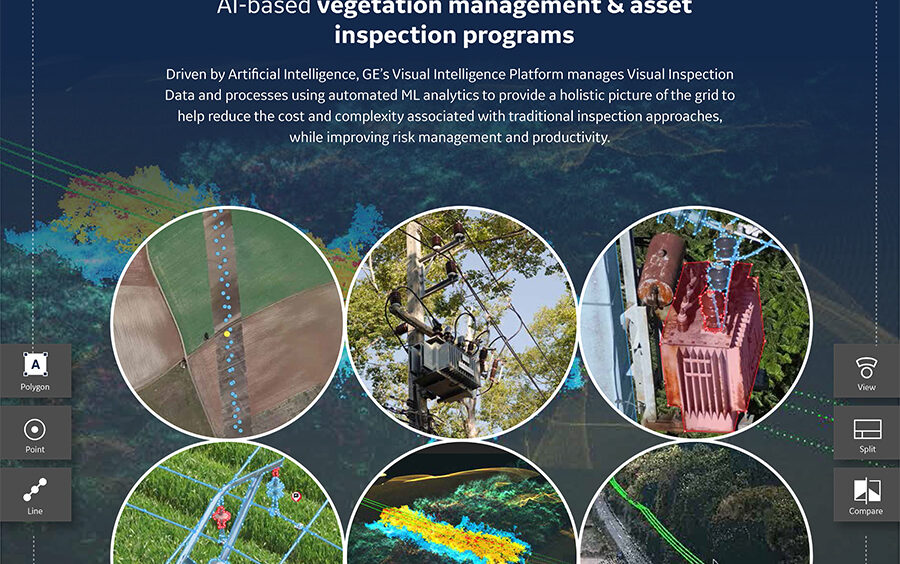GE Digital introduced a purpose-built Visual Intelligence Platform for utilities. The SaaS solution is designed to ingest all forms of visual inspection data and executes workflows and automated analysis which contextualizes data into Digital Twins of the network and environment. The Digital Twin generates business intelligence that is consumable, shareable, and actionable to drive an expected 27% cost savings versus current practices.
Today, global T&D utilities spend millions of dollars per year on vegetation management and asset inspection programs to reduce outages, increase compliance, improve safety, and reduce the probably of catastrophic events such as wildfires or major regional outages.
“Management of vegetation in transmission and distribution corridors is key to providing a reliable supply of electricity, and ensure public and worker safety,” said Jim Walsh, General Manager for GE Digital’s Grid Software business. “Our Visual Intelligence solution provides data-driven insights to reduce operational costs of survey data management, increase reliability and safety, and reduce liability risk.In today’s digital world, predictive analytic technology certainly has a part to play- especially within the world’s fastest moving digital utilities, as they drive the direction of the digital utility of tomorrow.”
Traditional approaches to Asset Inspection and Vegetation Management are slow and often based on Fixed Annual Cycles. Trees that are too close to power lines are a significant hazard and a major cause of power failures during high winds and storms. In dry weather conditions, branches touching the lines can catch fire, endangering human life, causing tremendous damage to the environment and existing infrastructures and putting utilities liability at risk. Visual inspections generate large amounts of data which are often reviewed manually, which is labor and time expensive. Measuring electrical corridors, trees, incursions, and clearances with LiDAR mounted on helicopters or similar is standard industry practice, but how do you turn this data into insights to improve reliability and safety with less cost?
Today, new remote sensing technology, surveying methods, and AI-enabled data management solutions are available which offer utilities a clear upgrade path from their legacy inspection and risk management programs.
One European DSO wanted to reduce the cost of helicopter / on-land inspections while increasing precision and frequency of inspections for overhead distribution lines. The Visual Intelligence solution automated the inspection process by generating a Network Digital Twin, detecting vegetation encroachment risks and providing predictive pruning strategies and accurate asset defect detection. The results:
- Completeness of automated asset classification in the Network Digital Twin: 95%
- Reduced vegetation management costs by 27%
- Reduced legacy inspection related downtime by 30%
“Billions of dollars are spent each year maintaining network assets and ensuring they are cleared of encroaching vegetation,” said Mike Kelly, Senior Research Analyst, Guidehouse Insights. “For most utilities, site inspections and vegetation management are performed as they were decades ago. However, artificial vision, particularly visual AI-based analytics, as offered by GE Digital’s Visual Intelligence solution, has the potential to transform the vegetation management paradigm. Sophisticated analysis of varied and complex datasets in a visual manner enables more predictive maintenance resulting in optimized resource allocation, reduced O&M spend alongside increased safety and network reliability.”
Predictive analytics are changing the way digital utilities make business decisions as the benefits of Artificial Intelligence (AI) and Machine Learning (ML) are recognized across the industry. GE’s Visual Intelligence Platform supports the ingestion of all major visual inspection filetypes. This allows for the optimal blend of image types to drive the highest value through the core Vegetation Management and Asset Inspection use cases. The Platform’s built-in Artificial Intelligence features drive automated identification of encroachment areas (driven by each utility’s parameters) and asset defects with increased precision provided thru additional training.
All visual inspection data is automatically ingested and processed, reducing significantly the need for manual quality review tasks.Key features include:
- Capturing and transmitting very large inspection files and processing them on a platform that specializes in 2D and 3D visual rendering
- Applying AI and machine learning to auto-identify high risk encroachment areas
- Mitigating failure threats with automated Asset, Component and Defect Visual Recognition
- Scaling to support infrastructures that can be many thousands of miles or kilometers long
- Integrating with current mission critical T&D software that includes GIS, ADMS and/or EMS
GE Digital has worked closely over the last year with the newlyformed Alteia, formerly a division of France-based Delair, to develop and deploy a large production-scale visual data platform with AI applications, that is the basis of the Visual Intelligence solution.
GE Digital’s Visual Intelligence platform is generally available. More information can be found here.






Comments are closed.